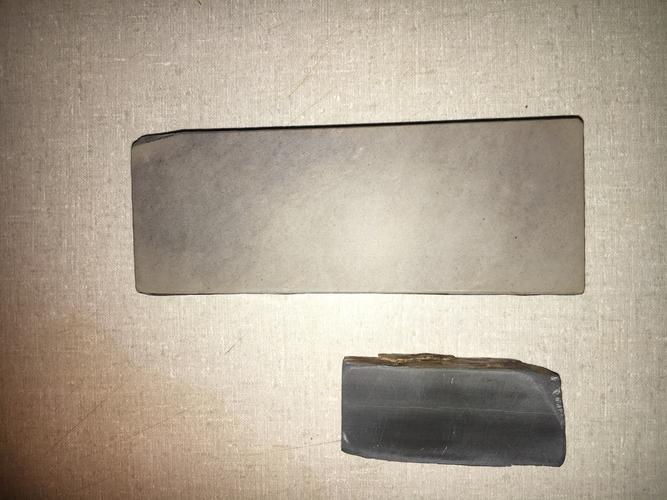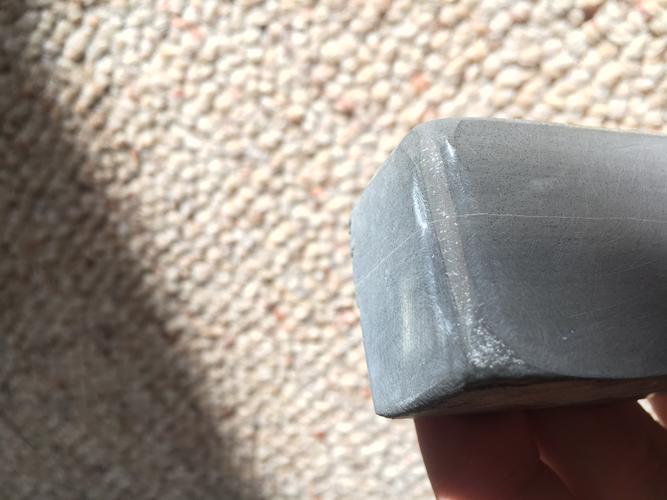Results 41 to 50 of 58
Thread: Tomonagura confusion
-
01-30-2019, 01:01 AM #41

Round the length of an edge and use that rounded edge to make a slurry. Or yes lift the edge so there is less contact area. If it is not scratching keep going , it may take a lot of time and effort.
I don't think I have ever had a diamond come away from the plate, it would be a rare occurrence.
Invest in a DMT 325 , it will last you a life time ..
Probably the loose glass has washed away but is it worth taking that chance..
Good luck
-
01-30-2019, 01:16 AM #42Senior Member



- Join Date
- Apr 2012
- Location
- Diamond Bar, CA
- Posts
- 6,553
Thanked: 3215
So, how are your edges?
It all does not matter if your edges are good and scratch free.
Once a diamond plate is broken in, it will not release diamonds on a soft stone, an Ark or super hard stone is another matter.
Post a pic of your Nagura
-
01-30-2019, 02:13 AM #43Senior Member

- Join Date
- Jun 2015
- Location
- Los Angeles
- Posts
- 104
Thanked: 19
I’m kind of confused by the “or” here. I used soft nagura first, but the tomo between them and the water. With the diamond plate, are you suggesting skip the tomo, rub the base stone and use the slurry to both polish the stone and the razor? Wouldn’t that be done after the nagura anyway?
On an aside, then, if this was the case, the diamond plate would also be maintaining the surface of the hone, right? Do I need a specific grit of diamond plate to keep the surface at a honing smoothness?
-
01-30-2019, 02:23 AM #44Senior Member

- Join Date
- Jun 2015
- Location
- Los Angeles
- Posts
- 104
Thanked: 19
It’s a new set. I did an edge with a tenjyo/mejiro/water orogression and the edge was good but not quite how it should be. So I went back and did the same progression but with the tomo (where I got the scratches). Will test that edge tomorrow.
I’ve worked the scratches off the hone with 400 grit sandpaper. The scratches on the tomo are from 220 (I started smoothing it again but didn’t finish). It did have bigger scratches too from when it scratched the hone, but less severe.
-
01-30-2019, 03:35 AM #45Senior Member



- Join Date
- Apr 2012
- Location
- Diamond Bar, CA
- Posts
- 6,553
Thanked: 3215
There are many roads to Rome and they all can work, depending on the stone (s) technique and the razor.
Check out Alex Gilmore’s, The Japan Stone. He has tons of Youtube video showing various Jnat honing methods. Then experiment.
Round the corners of the nagura. If the scratches on the stone and nagura do not affect the quality of the edge, it does not matter.
-
01-30-2019, 11:20 AM #46Member

- Join Date
- Dec 2018
- Posts
- 52
Thanked: 13
I have a few different doings for this, based on what worked best for a particular stone (not only Jnats).
1. Making slurry on the edges of the stone itself, using a harder dressing stone. Does wonders with a couple of Jnats and several other natural stones. The edges will wear a bit, but in the last few years nothing major.
2. Making slurry with the "edge" of the tomo itself by going the round way. Actually this works well even when the normal approach would be trouble free. I've got two that previous owners already used them like this. One is on a Jnat, the other on an Escher.
3. Putting some shallow channels with round edges on very fine and hard tomos also did wonders. I use two of them like that these days, but I've tried it several times.
4. The diamond plate way, making sure it's broken in at least (I use them on a novaculite before anything else and so far so good). This might be troublesome with some stones, as you need to find the right sweet spot for the surface. On some, a worn out 600 is plenty enough, on one I had to go even to my 2000 (this was hard to guess at first) for best possible results, going back and forth between them and comparing edges. This is one reason not everyone is in favor of diamond plates based on their own experiences. At some point I was for using small DMT plates, but over time I saw they developed a problem. Since it was on all 4 of them, I've stopped using them entirely. Some diamond resin pads work well with some stones, even not natural ones and are more trouble free, but also quite slow.
Of course I've talked to people searching just for the right tomo for a long time and I've been at it myself in the past. That's one way of doing it also. For one very hard and fine Nakayama, I have only one tomo that worked best. And on my kiita, another that was spot on. I've paid 50$, but well worth the money as I'm happy with it ever since.
Now keep in mind that cosmetics aren't always the definitive factors for the quality of an edge. I ended up enjoying edges that looked more or less bad (let's just say not perfect) and not so much some edges that were a beauty to look at. At the end of the day, it's about shaving more than anything else, for me at least. This goes for the stones as well. If the scratches do not impact the edge, just let it be, let it be...
Sandpaper at some point might release particles into the surface (some say diamond plates do this as well). I don't enjoy sandpaper for that many things actually. There is always a cheaper and/or better way on the long run.
-
01-30-2019, 05:12 PM #47Senior Member

- Join Date
- Jun 2015
- Location
- Los Angeles
- Posts
- 104
Thanked: 19
-
01-30-2019, 06:17 PM #48Member

- Join Date
- Dec 2018
- Posts
- 52
Thanked: 13
I'll try. I have to dig them all up. I'm not really sure where the (2)s are at the moment.
The first one might not be very popular. You run the hard or harder stone along the edges. The second is mentioned above as well. Same idea. And for the 3rd one, I'm pretty sure it's popular with some guys as well and while most use a cross or a similar pattern, I do them in a different manner, but again same idea. A quick search got me this as reference https://goo.gl/images/T6YZjt
These are tiny details that sometimes can make you love a stone and not rather smash it with a hammer.
-
The Following User Says Thank You to cman670 For This Useful Post:
ffourteen (01-30-2019)
-
01-30-2019, 07:06 PM #49

I would be worried the scratches are a symptom of toxic inclusions. What scratches the hone will scratch the bevel when released into the slurry.
Plus ça change, plus c'est la même chose. Jean-Baptiste Alphonse Karr.
-
01-30-2019, 08:13 PM #50Senior Member

- Join Date
- Jun 2015
- Location
- Los Angeles
- Posts
- 104
Thanked: 19
The thought crossed my mind. I rounded the edge and tried just with that, both with the whole edge (across the small crack) and just the corner area (see the extra wear on the bottom left). Still scratching, though less deep than when I used the whole side.
The little white scratches along the edge were not there before I took the tomo to the base stone. They seem to correspond to black flecks in the tomo, and look a lot like the scratches in the base stone. Could those be toxic inclusions?


 16Likes
16Likes LinkBack URL
LinkBack URL About LinkBacks
About LinkBacks








 Reply With Quote
Reply With Quote